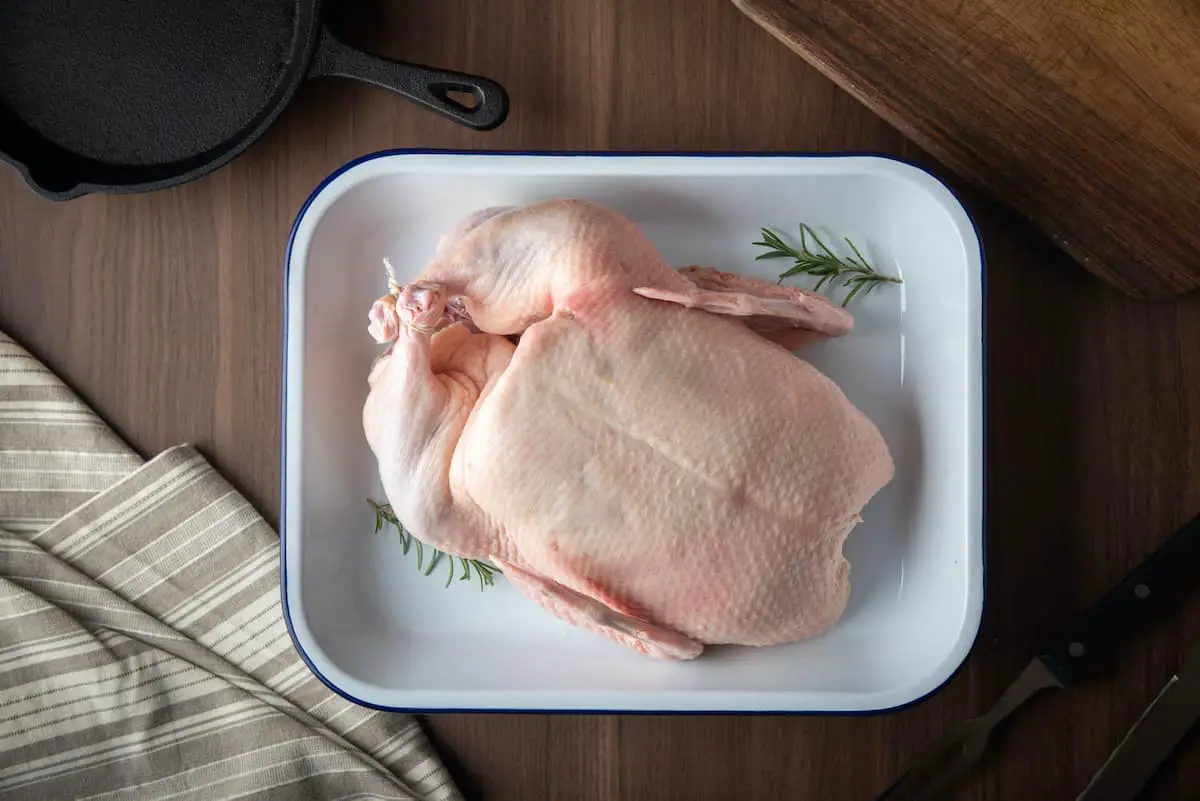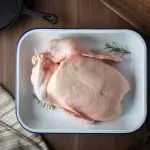Introduction :
Mastering the skill of butchering a duck opens up a world of culinary possibilities, allowing you to create delectable dishes from scratch. Whether you’re a home cook looking to elevate your cooking repertoire or a culinary enthusiast eager to delve into the intricacies of poultry preparation, this guide is designed to equip you with the knowledge and techniques needed to expertly handle a whole duck. From understanding the anatomy of the bird to mastering precise cuts, we’ll take you through each step of the butchering process in detail. Along the way, we’ll provide expert tips, explore nutritional benefits, offer variations to inspire your creativity, and address common questions to ensure your journey into duck butchery is both rewarding and enjoyable. So, roll up your sleeves, sharpen your knives, and let’s embark on this culinary adventure together.
Ingredients:
- 1 whole duck
Directions:
- Place the duck on a clean cutting board, breast side up.
- Using a sharp boning knife, make an incision along the breastbone, starting from the neck to the tail.
- Carefully separate the skin from the breast meat, working your way around the bird.
- Once the breast is exposed, locate the joint connecting the wing to the body and cut through it.
- Repeat the process on the other side to remove the second wing.
- Next, remove the legs by pulling them away from the body and cutting through the joint where they meet the body.
- Separate the thighs from the drumsticks by cutting through the joint.
- To remove the breasts, slice along the breastbone and carefully cut around it, following the natural curvature of the bones.
- Finally, trim away any excess fat or skin as desired.
Expert Tips for Serving and Storage:
- Serve freshly butchered duck in your favorite recipes like roast duck, confit, or duck breast salad.
- Store butchered duck parts in airtight containers or freezer bags in the refrigerator for up to 2 days, or freeze for longer storage.
Nutritional and Health Benefits:
- Duck is rich in protein, providing essential amino acids for muscle growth and repair.
- It contains healthy fats, particularly monounsaturated and polyunsaturated fats, which are beneficial for heart health.
- Duck is a good source of vitamins and minerals such as iron, zinc, and B vitamins, important for energy metabolism and immune function.
Variations to Explore:
- Experiment with different seasoning blends or marinades before cooking the duck parts.
- Try smoking or grilling the duck for added flavor.
- Use butchered duck in traditional dishes from various cuisines, such as Peking duck or French duck confit.
Conclusion:
Learning how to butcher a duck allows you to prepare various delicious dishes at home using different parts of the bird. With some practice and attention to detail, you can master this essential culinary skill and elevate your cooking repertoire.
Frequently Asked Questions:
- Can I use the leftover duck bones for making soup?
- Yes, leftover duck bones can be used to make a flavorful duck broth or soup. Simmer the bones along with aromatics like onions, carrots, celery, and herbs in water for several hours to extract maximum flavor. Strain the broth and use it as a base for soups or sauces.
- What is the best way to store butchered duck for later use?
- The best way to store butchered duck for later use is to refrigerate or freeze it promptly. If refrigerating, store the duck in an airtight container or wrap it tightly in plastic wrap or butcher paper. If freezing, wrap the duck in several layers of plastic wrap or foil to prevent freezer burn, or vacuum-seal it if possible.
- Are there any safety precautions I should take while butchering a duck?
- Yes, there are several safety precautions to take while butchering a duck:
- Use sharp knives to minimize the risk of accidents.
- Keep your work area clean and sanitized to prevent cross-contamination.
- Wash your hands thoroughly before and after handling raw duck to avoid foodborne illnesses.
- Use separate cutting boards and utensils for raw duck to prevent cross-contamination with other foods.
- Yes, there are several safety precautions to take while butchering a duck:
- Can I use the giblets and offal from the duck for cooking?
- Yes, the giblets (such as the liver, heart, and gizzard) and other offal from the duck can be used for cooking. They add depth of flavor to dishes like gravies, sauces, or stuffing. Make sure to clean and trim them properly before incorporating them into your recipes.
- How do I know when the duck is properly butchered?
- You can tell if a duck is properly butchered by several indicators:
- The cuts should be clean and precise, with no ragged edges or uneven pieces.
- The meat should be firm and well-trimmed, with excess fat removed.
- Joints should be properly separated, and bones should be cleanly cut.
- If the duck is being portioned, pieces should be uniform in size to ensure even cooking.
- You can tell if a duck is properly butchered by several indicators:
Resources :
- How to Butcher a Duck: Step-by-Step Guide
- Tips for Butchering Poultry
- Choosing and Preparing Duck Meat
- Health Benefits of Eating Duck
- Recipes Using Duck Parts
You May Also Like :
PrintHow to Butcher a Duck
Discover the art of duck butchery with our comprehensive guide. Learn step-by-step instructions, expert tips, and nutritional benefits. Explore variations and find answers to frequently asked questions. Plus, delve into external resources for further insights.
- Prep Time: 15 minutes
- Total Time: 15 minutes
- Yield: 1 butchered duck 1x
- Category: Main Course
- Method: Butchering
- Cuisine: Multi-cultural
- Diet: Vegetarian
Ingredients
1 whole duck
Instructions
- Place the duck on a clean cutting board, breast side up.
- Using a sharp boning knife, make an incision along the breastbone, starting from the neck to the tail.
- Carefully separate the skin from the breast meat, working your way around the bird.
- Once the breast is exposed, locate the joint connecting the wing to the body and cut through it.
- Repeat the process on the other side to remove the second wing.
- Next, remove the legs by pulling them away from the body and cutting through the joint where they meet the body.
- Separate the thighs from the drumsticks by cutting through the joint.
- To remove the breasts, slice along the breastbone and carefully cut around it, following the natural curvature of the bones.
- Finally, trim away any excess fat or skin as desired.
Notes
- Ensure your cutting board and knife are clean and sanitized before beginning the butchering process.
- Take your time and work carefully, especially around the joints, to avoid damaging the meat.
- You can save the duck carcass for making stock or broth.
Nutrition
- Serving Size: 1 duck (approximately 4 servings)
- Calories: 1900 kcal
- Sugar: 0g
- Sodium: 230mg
- Fat: 170g
- Carbohydrates: 0g
- Fiber: 0g
- Protein: 90g
- Cholesterol: 390mg
Keywords: How to Butcher a Duck


